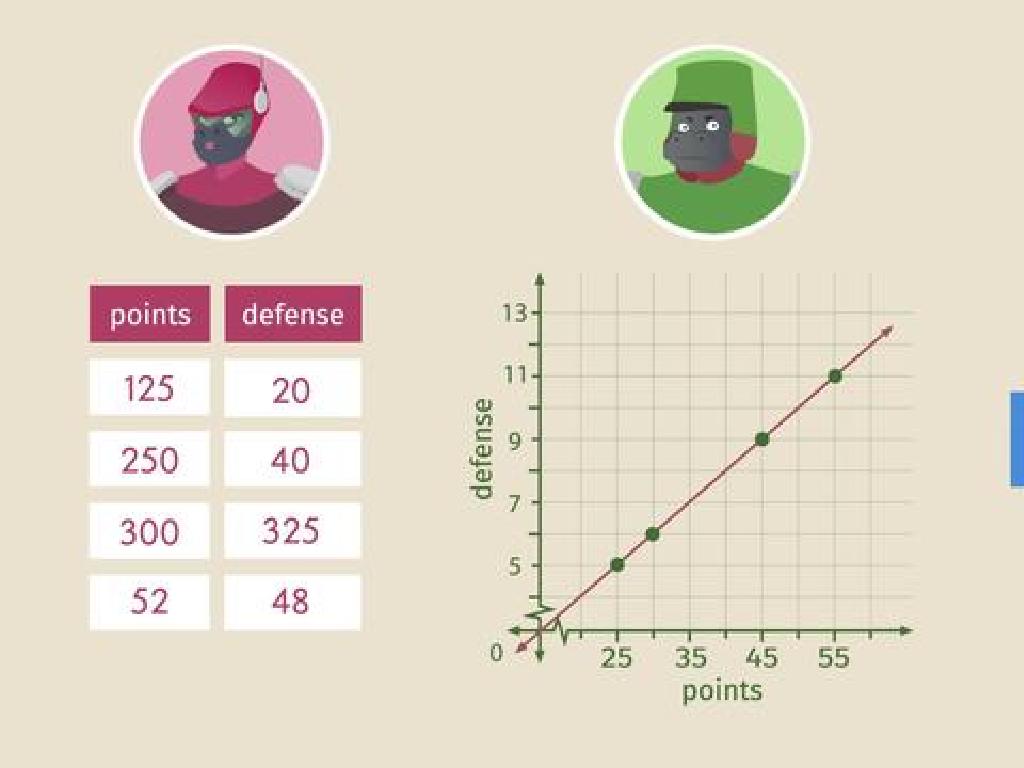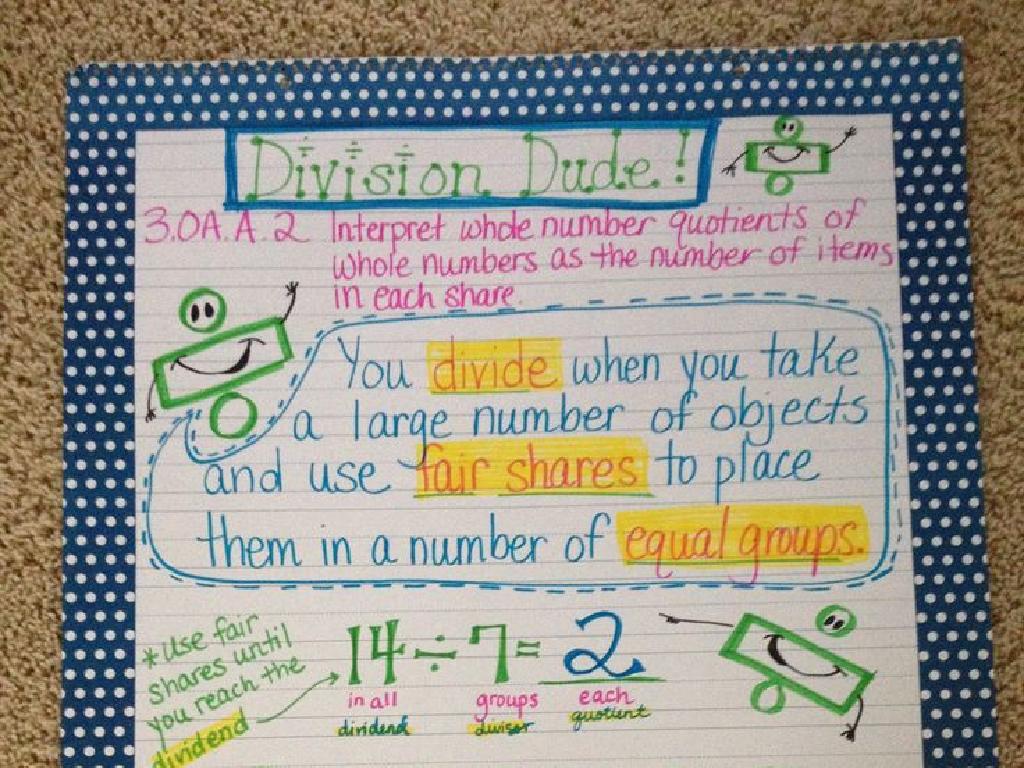Rate Of Change: Tables
Subject: Math
Grade: Eighth grade
Topic: Interpret Functions
Please LOG IN to download the presentation. Access is available to registered users only.
View More Content
Welcome to Rate of Change!
– Understanding rate of change
– It’s the speed at which a variable changes over time.
– Real-life applications
– Helps in predicting trends, like stock prices or speed.
– Rate of change from tables
– How to calculate from data in tables.
– Today’s lesson overview
|
This slide introduces the concept of rate of change, which is a fundamental idea in mathematics and represents how a quantity changes over time. Emphasize the importance of understanding this concept as it applies to various real-life situations, such as economics, physics, and everyday problem-solving. Provide examples like the rate at which a car’s speed changes or how quickly prices rise. The lesson will focus on interpreting and calculating the rate of change from data presented in tables, a skill that will enhance students’ ability to analyze functions and understand trends. Encourage students to think of situations where they have observed changes over time and how rate of change could be a useful measure.
Understanding Rate of Change
– Define rate of change
– The speed at which a variable changes over a specific period of time.
– Link rate of change to slope
– Rate of change is the slope in coordinate geometry, representing steepness.
– Real-world rate of change examples
– Examples: Speed of a car, growth of a plant over time.
– Analyzing rate of change in tables
|
The rate of change is a fundamental concept in mathematics that describes how a quantity changes over time. It’s important for students to understand that this concept is the same as the slope of a line in a graph. The slope is the ‘steepness’ of the line, which can be calculated by the change in y over the change in x. Provide real-world examples to illustrate the concept, such as the speed of a car (distance over time) or the growth of a plant (height over time). Encourage students to think of other examples they encounter in daily life. Finally, demonstrate how to calculate and interpret the rate of change from data in tables, which is a practical skill for many real-world applications.
Exploring Rate of Change Using Tables
– Interpreting data in tables
– Identify independent vs. dependent
– Independent: input/x-values, Dependent: output/y-values
– Calculate differences in y-values
– Subtract y-values vertically in the table
– Calculate differences in x-values
– Subtract x-values horizontally in the table
|
This slide introduces students to the concept of rate of change using tables. Start by explaining how to read and interpret the data presented in tables. Clarify the roles of independent (input or x-values) and dependent variables (output or y-values) in the context of functions. Teach students how to find the rate of change by calculating the differences between y-values (rise) and x-values (run). Emphasize that the rate of change is consistent in linear functions. Provide examples of tables with different rates of change and guide students through the process of calculating these rates. Encourage students to practice with additional tables to solidify their understanding.
Calculating Rate of Change from Tables
– Formula for rate of change
– Rate of change = (change in y) / (change in x)
– Apply formula to table data
– Use table values to calculate change in y and x
– Work through varied table examples
– Practice with linear, quadratic, and other tables
– Understand rate of change significance
|
This slide introduces the concept of rate of change and how to calculate it using a formula. The rate of change is a crucial concept in understanding how functions behave. It tells us how much the dependent variable (y) changes for a unit change in the independent variable (x). Students will learn to apply this formula to data presented in tables, which is a common way to display information in math and science. Provide examples using different types of tables to show how the rate of change can be consistent (linear functions) or variable (non-linear functions). Emphasize the importance of understanding the rate of change as it applies to real-world situations, such as speed and economics.
Rate of Change in Real Life
– Daily life rate of change
– Speed of a car example
– If a car travels 60 miles in 1 hour, its speed (rate of change) is 60 mph
– Plant growth rate
– A plant grows 2 inches in a month, so its growth rate is 2 inches/month
– Interpreting rate of change
– Understand how to calculate and interpret the rate at which things change over time
|
This slide aims to help students understand the concept of rate of change by relating it to familiar real-life scenarios. Discuss how the speed of a car is a rate of change, measuring distance over time. Similarly, the growth of a plant over time is another example. Emphasize that rate of change is all about how much something changes over a given period. Encourage students to think of other examples in their daily lives where they can observe rates of change. This will help them grasp the concept and apply it to various contexts, including mathematical functions and tables.
Calculating Rate of Change
– Work on practice problems
– Calculate rate from tables
– Find the change in y over the change in x
– Discuss various approaches
– How did you approach the problem?
– Share and compare answers
– Understand there can be multiple methods to find the solution
|
This slide is designed for a collaborative classroom activity where students will engage in solving practice problems focused on calculating the rate of change from tables. Start by working through a few problems as a class to demonstrate the process. Students should then practice calculating the rate of change on their own, using the change in the dependent variable (y) over the change in the independent variable (x). Facilitate a class discussion to explore different methods students used to find their answers. Encourage them to share their thought processes and compare results with their peers. This will help them see the variety of ways a problem can be approached and reinforce their understanding of the concept. Provide guidance and clarification as needed.
Group Activity: Exploring Rate of Change
– Divide into small groups
– Each group gets a unique table
– Calculate the rate of change
– Use the formula (change in y) / (change in x)
– Present findings to the class
|
This group activity is designed to foster collaborative learning as students explore the concept of rate of change using tables. Divide the class into small groups, ensuring a mix of abilities in each to support peer learning. Provide each group with a different table of values, which could represent various real-world functions. Guide them to calculate the rate of change by finding the difference in the y-values divided by the difference in the x-values. Encourage each group to discuss their strategy and findings before presenting to the class. Possible activities: analyzing distance-time tables for different vehicles, comparing temperature changes over time, or examining the cost of items in bulk purchases. This will help students understand how the rate of change is a measure of how one quantity changes in relation to another.
Class Activity: Plant Growth Rate
– Measure plant height over time
– Record data in a table
– Calculate plant growth rate
– Use the formula (change in height)/(change in time)
– Discuss real-world implications
– How does this relate to real-life scenarios?
|
This activity is designed to help students understand the concept of rate of change through a hands-on approach. Students will measure the height of a plant at regular intervals, recording their data in a table. They will then use the collected data to calculate the rate of change of the plant’s growth. This will involve finding the difference in height over the difference in time. Teachers should guide students through setting up their tables and performing the calculations. Possible variations of the activity could include measuring different types of plants or comparing growth rates in different conditions, such as varying light levels. This exercise will not only solidify their understanding of rate of change but also highlight its importance in everyday life, such as in biology and environmental science.
Review and Q&A: Rate of Change
– Recap today’s key points
– Open floor for questions
– Address student doubts
– Provide extra examples
– For instance, if a car travels 60 miles in 1 hour, the rate of change is 60 miles per hour.
|
This slide is meant to summarize the main concepts of the rate of change from tables and to engage students in a Q&A session. Start by reviewing the definition of rate of change and how it can be determined from a table of values. Encourage students to ask questions about any part of the lesson they found challenging. Be prepared to clarify doubts, possibly by revisiting some of the tables used during the lesson. Offer additional examples to solidify their understanding, such as real-life scenarios where rate of change is evident. This interactive session will help ensure that students are ready to apply these concepts to problems independently.
Homework: Exploring Rate of Change
– Solve rate of change problems
– Find real-life tables for practice
– Examples: sports statistics, stock market data
– Interpret graphs in the next class
– Review homework in the next session
– We’ll discuss solutions and challenges faced
|
This homework assignment aims to reinforce the concept of rate of change using tables. Students should solve the problems provided in their textbooks or worksheets. Additionally, they should seek out tables from real-world sources like newspapers or the internet, such as sports statistics or financial data, to find practical applications of the concept. Remind students that the ability to interpret graphs will be crucial in the next class, so they should come prepared. During the next session, allocate time to review the homework, discuss the solutions, and address any difficulties the students encountered. This will help ensure they have a solid understanding of how to calculate and interpret the rate of change.





